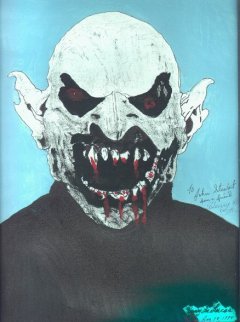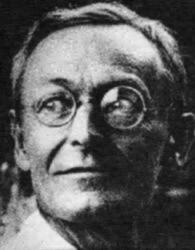“I have only one superstition. I touch all the bases when I hit a home run.” — Babe Ruth
Month: January 2005
Group Hug
“I once was waiting for an elevator and when the doors opened, there was a baby there on the floor of the elevator in the car seat. Instead of taking the baby out, I instead waited for the doors to close and take the baby to another floor.”
Group Hug lists 167,394 anonymous confessions.
Invisible Pink Unicorn
 Who says atheists don’t have a sense of humor? The Invisible Pink Unicorn (“blessed be her holy hooves”) was “revealed to” the Usenet newsgroup alt.atheism in 1990.
Who says atheists don’t have a sense of humor? The Invisible Pink Unicorn (“blessed be her holy hooves”) was “revealed to” the Usenet newsgroup alt.atheism in 1990.
Since then, she’s acquired all the trappings of a real deity: gospels (“according to St. Sascha”), revelations (to “St. Bryce the Long-Winded”), relics (the Holy Sock of Bob), scripture, and historic artworks.
Because she’s invisible, it’s impossible to prove she does not exist. “The Invisible Pink Unicorn is a being of great spiritual power,” say the faithful. “We know this because she is capable of being invisible and pink at the same time. Like all religions, the Faith of the Invisible Pink Unicorn is based upon both logic and faith. We have faith that she is pink; we logically know that she is invisible because we can’t see her.”
Followers debate her attributes, but it’s generally agreed that she prefers pineapple and ham pizza to pepperoni and mushroom, which is said to be eaten only by followers of the Purple Oyster of Doom. The IPU also “raptures” socks from laundry as a sign of favor.
Is this harmless fun or awful blasphemy? It’s getting hard to care. As the French writer Edmond de Goncourt wrote, “If there is a God, atheism must seem to him as less of an insult than religion.”
Unquote
“Don’t be humble. You’re not that great.” — Golda Meir
Serial Killer Art Review
 YuppiePunk’s Serial Killer Art Review presents the jailhouse compositions of 14 career murderers.
YuppiePunk’s Serial Killer Art Review presents the jailhouse compositions of 14 career murderers.
This piece is the work of Henry Lee Lucas, whose pathetic life was dramatized in the film Henry: Portrait of a Serial Killer.
Born to a legless alcoholic and a violent prostitute who shot his pony and beat him into a coma, Lucas lost an eye and experimented with bestiality as a teenager before stabbing his mom and launching a one-man crime wave.
He eventually confessed to 3,000 murders; if that’s true, he killed someone every day between 1975 and 1983. Kind of explains why he didn’t paint still lifes.
If you’re into this stuff, check out John Douglas’ disturbing book Mindhunter. A former FBI profiler, Douglas inspired Scott Glenn’s character in The Silence of the Lambs.
After studying sociopaths for 25 years, Douglas could examine a crime scene and give an uncannily accurate description of the killer: he has a speech impediment, he drives a red Volkswagen Beetle, he owns a German shepherd, he lives with sisters. And he’d be right. That’s one talent I don’t envy.
Irrational Slumber
In 1610, Ludolph van Ceulen died of exhaustion after deriving 35 decimal digits of pi.
They’re engraved on his tombstone.
Error Message Generator

Create your own Windows error messages with Atom Smasher’s new utility.
Holyoke Rules
Rules, Mt. Holyoke College, 1837:
- No young lady shall become a member of Mt. Holyoke Seminary who cannot kindle a fire, mash potatoes, and repeat the multiplication table and at least two-thirds of the shorter catechism.
- Every member of the school shall walk a mile a day unless a freshet, earthquake, or some other calamity prevent.
- No young lady shall devote more than an hour a day to miscellaneous reading.
- No young lady is expected to have gentlemen acquaintances unless they are returned missionaries or agents of benevolent societies.
The Glass Bead Game
 If there’s a master’s cup for science-fiction visionaries, it might actually belong to Hermann Hesse. In a late novel, the German author seemed to imagine the World Wide Web, and its kaleidoscopic hyperlinks, fifty years before it existed.
If there’s a master’s cup for science-fiction visionaries, it might actually belong to Hermann Hesse. In a late novel, the German author seemed to imagine the World Wide Web, and its kaleidoscopic hyperlinks, fifty years before it existed.
Das Glasperlenspiel, which won the Nobel Prize in 1946, centers on “the Glass Bead Game,” in which players combine the symbols of world cultures into new and insightful combinations. Here’s his description of the game — see if this doesn’t sound like the Web:
“The Glass Bead Game is thus a mode of playing with the total contents and values of our culture; it plays with them as, say, in the great age of the arts a painter might have played with the colors on his palette. All the insights, noble thoughts, and works of art that the human race has produced in its creative eras, all that subsequent periods of scholarly study have reduced to concepts and converted into intellectual values the Glass Bead Game player plays like the organist on an organ. And this organ has attained an almost unimaginable perfection; its manuals and pedals range over the entire intellectual cosmos; its stops are almost beyond number. Theoretically this instrument is capable of reproducing in the Game the entire intellectual content of the universe.”
Hesse never quite explains how the game is played, which has set a lot of modern designers working on playable variants. The most popular is Charles Cameron’s HipBone Game (here’s an example of a board game, but Cameron’s working on a web-based version). This bears watching: The web is constantly evolving, and perhaps Hesse’s vision is still ahead of us.
” “
The This Page Intentionally Left Blank Project “offers Internet wanderers a place of quietness and simplicity on the overcrowded World Wide Web.”
